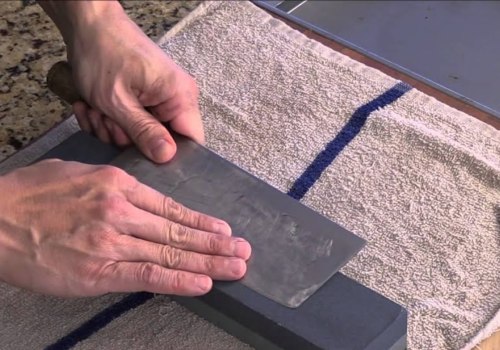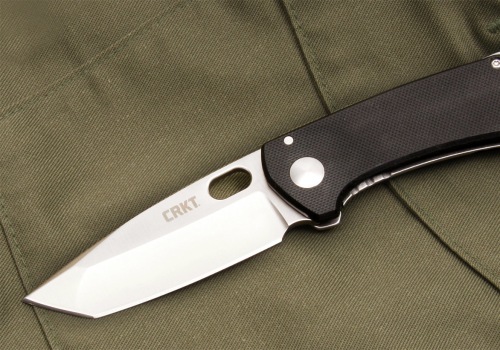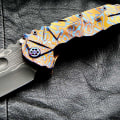Tactical knives are widely used for a variety of purposes, from self-defense to hunting and recreational activities. However, with great power comes great responsibility, and safe handling of these powerful knives is essential in order to prevent injuries and accidents. In this article, we will explore the key safety tips you need to know when handling tactical knives. We will discuss proper knife maintenance and storage, as well as how to properly handle and use your tactical knife in a safe manner.
To start off
, it's important to select the right knife for the job.Different types of knives are designed for different tasks. For instance, a folding knife is great for everyday carry, while a fixed blade knife is better suited for more demanding tasks. It's important to select a knife that is appropriate for the job at hand, as this will ensure that you are using the right tool and are less likely to get injured. Once you have selected the right knife, it's important to practice proper storage. Always make sure to store knives in a secure location where they are out of reach of children and other individuals who may not be familiar with knife safety.
It's also important to regularly inspect your knives for signs of wear and tear or damage, as this can affect their performance and safety. When it comes to cleaning and maintenance, it's important to follow the manufacturer's instructions. Different materials require different cleaning techniques, so make sure to read the manufacturer's manual before cleaning your knives. In addition, regular sharpening is important for keeping your knives in good working order. Finally, it's important to always practice safe handling techniques when using tactical knives. Make sure to keep your fingers away from the blade when cutting and always use a cutting board or other surface to protect your hands from accidental contact with the blade.
Additionally, always make sure that the blade is fully open before using it and never force it open with your hands. These are just a few of the safety tips for handling tactical knives. By following these guidelines and practicing safe knife handling techniques, you can ensure that you and your family stay safe.
Proper Storage
Proper storage of tactical knives is essential for safety and security. If knives are not stored correctly, it can increase the risk of injury, theft, or damage to the knife itself. It's important to choose a secure storage location, such as a locked cabinet or drawer, that is out of reach of children and other unauthorized individuals.Additionally, it's important to store knives away from extreme temperatures, moisture, and dirt. When storing multiple knives together, it's important to wrap them in a protective material to ensure that they do not scratch or damage each other. Additionally, knives should be stored with their blades facing down in a secure sheath or container. Keeping tactical knives in a secure location will help ensure that they are not misplaced or damaged, and that only authorized individuals can access them.
Selecting the Right Knife
Choosing the right knife for the job is essential for safe handling of tactical knives. Different tactical knives have different uses, and it is important to understand the purpose of each type of knife before selecting one. By selecting the right knife for the job, you will ensure that it is used safely and correctly. There are several types of tactical knives, including folding, fixed blade, multi-tools, and automatics. Folding knives are great for everyday carry and portability.Fixed blade knives are better suited for heavy-duty tasks such as survival, bushcraft, and hunting. Multi-tools typically feature multiple tools in one small package, making them ideal for a variety of tasks. Automatics are spring-loaded knives that open quickly and are great for self-defense. It is important to select the right knife based on its intended use. For instance, a folding knife may be great for light-duty cutting tasks, but not suitable for heavy-duty tasks such as cutting rope or wood.
Similarly, an automatic knife may not be suitable for general utility tasks such as opening packages. When selecting a tactical knife, it's important to consider the handle material and blade material. The handle should be comfortable to hold and provide a secure grip. The blade should be made from a durable material such as stainless steel or titanium that can withstand wear and tear. Additionally, the blade should be sharp enough to cut through materials with ease.
Safe Handling Techniques
When it comes to handling tactical knives, safety should always be a top priority.Proper knife safety techniques can help prevent serious injury and even death. It is essential to understand why safe handling techniques are important, as well as the different techniques that should be used. The most important reason for using safe handling techniques is to reduce the risk of injury. Tactical knives can be extremely sharp and, if handled improperly, can cause serious injury or even death.
In order to use the knife safely, it is important to understand the basic safety rules and follow them. Some examples of safe handling techniques include: using a cutting board when slicing or chopping food, keeping your fingers away from the blade when sharpening or cleaning the knife, and wearing protective gear such as gloves when handling a knife. Additionally, always make sure the knife is in a secure location when not in use and check the blade for damage before and after use. By following these basic safety guidelines, you can ensure that you are safely handling your tactical knife.
Proper knife safety is essential to avoid any potential accidents or injuries.
Cleaning & Maintenance
Cleaning and maintenance are important for the safe handling of tactical knives because it keeps them in the best condition for use. Cleaning a tactical knife ensures that it is free from dirt and debris which can interfere with proper functioning. Regular sharpening is also important for tactical knives as it keeps them sharp and ready for use.When cleaning a tactical knife, it is important to use a clean cloth and mild soap or detergent. It is also important to avoid using abrasive materials such as steel wool or scouring pads as these can damage the blade. It is also important to ensure that the knife is completely dry before storing or using it. Regular sharpening of a tactical knife can help keep it in optimal condition and prevent it from becoming dull or damaged.
Sharpening should be done with a sharpening stone and should be done in the same direction as the blade’s edge. Once sharpened, it is important to check the blade for any burrs or nicks before using it. By following these cleaning and maintenance tips, you can ensure that your tactical knife is always safe to use and in good condition. Proper care and maintenance will also help ensure that your knife lasts for many years to come. Using tactical knives safely requires understanding the basic safety guidelines and following them.
Selecting the right knife, proper storage, cleaning, and maintenance are all important steps to ensure safe handling of tactical knives. Taking the time to learn about knife safety and practice proper handling techniques will help keep you and your family safe.







Leave Reply